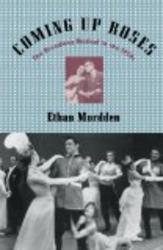Description
Coming Up Roses: The Broadway Musical in the 1950s is a book about the 1950s Broadway musical. Ethan Mordden gives a detailed account of the decade, highlighting the shift in Broadway from shows that showcased a big name talent to shows with more character and atmosphere. Musical conventions were polished, writing became more finely crafted, and dance became truly indispensable during this time. Mordden discusses the key players of the decade, such as Ethel Merman, George Abbott, Jerome Robbins, Gwen Verdon, Bob Fosse, Stephen Sondheim, Frank Loesser, Cole Porter, Leonard Bernstein, and many others. He also gives backstage scoop on why Guys and Dolls is so well-made, why West Side Story is so timeless, and why The King and I and Gypsy pushed the envelope. All this is peppered with industry gossip that made Broadway so nerve-wrackingly vibrant during this time. Coming Up Roses: The Broadway Musical in the 1950s is a detailed and passionate study of a crucial period in American musical theater.
The 1950s saw an explosion in the American musical theater. The Broadway show, catapulted into the limelight in the 20s and solidified during the 40s thanks to Rodgers and Hammerstein, now entered its most revolutionary phase, brashly redefining itself and forging a new kind of storytelling. In Coming Up Roses: The Broadway Musical in the 1950s, Ethan Mordden gives us a guided tour of this rich decade. With loving detail, Mordden highlights the shift in Broadway from shows that were mere star vehicles, showcasing a big-name talent, to the bolder stories, stuffed with character and atmosphere. During this period, subject matter became more intricate, even controversial, and plots more human and complex; Mordden demonstrates how, in response, musical conventions were polished, writing became more finely crafted, and dance became truly indispensable. Along the way we meet the key players: such greats as Ethel Merman, George Abbott, Jerome Robbins, Gwen Verdon, Bob Fosse, Stephen Sondheim, Frank Loesser, Cole Porter, Leonard Bernstein, and many others. We get the backstage scoop on why Guys and Dolls is so well-made, why West Side Story is so timeless, why The King and I and Gypsy pushed the envelope, and why no one ever talks about Ankles Aweigh. All this is peppered with a dash of industry gossip--the directorial struggles, last-minute script rewrites and cast replacements, the power of the poster listings--that made Broadway so nerve-wrackingly vibrant. This passionate and informed study illuminates a crucial period in American musical theater and shows us the origins of many of the musicals recently revived to huge success on Broadway.
This book begins its survey of a seminal decade in American theater in 1950, when the Broadway musical method in which stars like Ethel Merman slogged it out show after show, formula after formula, success after success had run its course, sparking the need for innovation. It ends in 1959, after a decade of innovation had raised the musical to new heights--heights that the genre would not maintain in later decades. In between, Ethan Mordden paints a picture of the musical that is warm and sympathetic, even as it pours cold water on what the author considers the medium's excesses and failures. Mordden isn't shy about sharing his opinions. He links the legendary director George Abbott to the stagnation that set in during the early '50s: "He was a journeyman, not a visionary. He was very, very good at what he knew how to do, and, like all conservatives, never attempted to do anything else." Regarding
Can Can he writes, "Clearly, what saved it at first was the score and the production; at length, its dippy book destroyed it." And, at odds with the millions who revere
The Sound of Music, Mordden acknowledges its "slight but extremely tuneful score," concluding that the show has a "somewhat disappointing position in the Rodgers and Hammerstein canon." Mordden praises
Guys and Dolls--"a classic" and
My Fair Lady--"it's culturally imperative ... capitalism at its best." Lenny Bernstein's
Candide is the "uniquely influential title" of the 1950s, "perhaps the last crucial revolutionary development in the musical's history." All this praise is lovingly spelled out in chapters that dwell on the productions themselves in a chunky narrative cluttered with an insider's look behind the scenes. Mordden's book forces readers to rethink much of what they know about the Broadway musical and to listen, and listen again, to their favorite soundtracks.
--Roy Wadia











